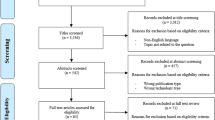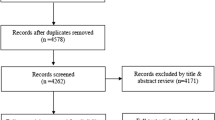Abstract
Web-based health information is particularly important for the increasing number of older adult online users. One strategy to deliver synthesized, evidence-based health information to these individuals is through Web-based learning modules. There is, however, a lack of research in the area of using Web-based learning for older adults. To assess the effects of Web-based health learning modules, older adults’ ability to use the modules must be assessed. This article described the development and testing of the psychometric properties of the Web-Based Learning Self-Efficacy Scale (WBLSES). Initially, the eight-item WBLSES was developed based on an in-depth review of the literature, prior findings, and expert consultation. Preliminary psychometric testing was conducted using a single group descriptive study (N = 33) and the WBLSES was then retested among a larger sample of 221 older adults. The findings supported the reliability of the WBLSES as evidenced by appropriate internal constancy and stability, and the validity through hypothesis testing and Rasch analysis. Further studies are needed using other Web learning programs and more diverse samples.
Similar content being viewed by others
References
Bandura, A. (1997). Self-efficacy: The exercise of control. New York: Freeman.
Bandura, A. (2005). Guide for constructing self-efficacy Scales. Retrieved October 2, 2007, from http://www.des.emory.edu/mfp/SE-Guide2005.html
Bezruczko, N. (2005). Rasch measurement in health sciences. Maple Grove, MN, USA: JAM.
Bond, T. G., & Fox, C. M. (2001). Applying the rasch model: Fundamental measurement in the human sciences. London: Erlbaum.
Compeau, D. R., & Higgins, C. A. (1995). Computer self-efficacy: Development of a measure and initial test. MIS Quarterly, 19, 189–211.
Echt, K. V. (2002). Designing Web-based health information for older adults: Visual considerations and design directives. In R. W. Morrell Older adults, health information, and the World Wide Web 61–87 Mahwah, NJ, USA: Lawrence Erlbaum.
Ertmer, P. A., Evenbeck, E., Cennamo, K. S., & Lehman, J. D. (1994). Enhancing self-efficacy for computer technologies through the use of positive classroom experiences. Educational Technology Research and Development, 42(3), 45–62.
Fox, S. (2004). Older Americans and the Internet. Retrieved October 1, 2007, from http://www.pewinternet.org/reports/toc.asp?Report=117.
Fox, S. (2006). Online Health Search 2006. Retrieved October 1, from http://www.pewinternet.org/pdfs/PIP_Online_Health_2006.pdf.
Gustafson, D. H., Hawkins, R. P., Boberg, E. W., McTavish, F., Owens, B., & Wise, M. et al. (2002). CHESS: 10 years of research and development in consumer health informatics for broad populations, including the underserved. International Journal of Medical Informatics, 65(3), 169–177.
Gustafson, D. H., McTavish, F., Hawkins, R., Pingree, S., Arora, N., & Mendenhall, J. et al. (1998). Computer support for elderly women with breast cancer. Journal of the American Medical Association, 280 1305.
Hendrix, C. C. (2000). Computer use among elderly people. Computers in Nursing, 18(2), 62–68.
Jones, B. D., & Bayen, U. J. (1998). Teaching older adults to use computers: Recommendations based on cognitive aging research Educational Gerontology, 24(7), 675–689.
Kukafka, R., Lussier, Y. A., Eng, P., Patel, V. L., & Cimino, J. J. (2002). Web-based tailoring and its effect on self-efficacy: results from the MI-HEART randomized controlled trial. AMIA Annual Symposium, 410–414.
Lenhart, A., Simon, M., & Graziano, M. (2001). The Internet and education: findings of the Pew internet & American life project. Retrieved November 16, from http://www.pewinternet.org/pdfs/PIP_Schools_Report.pdf.
Linacre, J. M. (2007) Winsteps (Version 3.63.2). Chicago, IL, USA: Winsteps.
Madden, M. (2006). Internet penetration and impact. Retrieved October 1, 2007, from http://www.pewinternet.org/pdfs/PIP_Internet_Impact.pdf.
Madden, M., & Fox, S. (2006). Finding Answers Online in Sickness and in Health. Retrieved October 1, 2007, from http://www.pewinternet.org/pdfs/PIP_Health_Decisions_2006.pdf.
Mayhorn, C. B., Stronge, A. J., McLaughlin, A. C., & Rogers, W. A. (2004). Older adult, computer training, and the systems approach: A formula for success. Educational Gerontology, 30(3), 185–203.
McKay, H. G., King, D., Eakin, E. G., Seeley, J. R., & Glasgow, R. E. (2001). The diabetes network internet-based physical activity intervention: a randomized pilot study. Diabetes Care, 24(8), 1328–1334.
Nahm, E. S., & Blum, K. (April 12–14, 2006). Exploration of Patients’ Readiness for a Heart Failure eHealth Management Program. Paper presented at the Eastern Nursing Research Society Annual Scientific, Providence, RI.
Nahm, E.-S., Preece, J., Resnick, B., & Mills, M. E. (2004). Usability of health Web sites for older adults: A preliminary study. CIN: Computers, Informatics, 22, 326–334,343.
Nahm, E. S., & Resnick, B. (2001). Homebound older adults’ experiences with the Internet and e-mail. Computers in Nursing, 19, 257–263.
Nahm, E.-S., Resnick, B., Bausell, B., Covington, B., Magaziner, J., & Brennan, P. F. (November 16–20, 2007). Lessons learned from conducting an online hip fracture prevention trial. Paper presented at the Gerontological Society of America’s 60th Annual Scientific Meeting, San Francisco, CA, USA.
Nahm, E.-S., Resnick, B., & Covington, B. (2006). Development of theory-based, online health learning modules for older adults: Lessons learned. CIN: Computers, Informatics, Nursing, 24(5), 261–268.
Nahm, E.-S., Resnick, B., & Gaines, J. (2004). Testing of the reliability and validity of the computer-mediated social support measures among older adults: A preliminary study. CIN: Computers, Informatics, Nursing, 22, 211–219.
Nahm, E.-S., Resnick, B., & Mills, M. E. (2003). A model of computer-mediated social support among older adults. AMIA Annual Symposium Proceedings, 948.
Nahm, E.-S., Resnick, B., & Mills, M. E. (2006). Development and pilot-testing of the perceived health Web site usability questionnaire (PHWSUQ) for older adults. Studies in Health Technology and Informatics, 122, 38–43.
Napolitano, M. A., Fotheringham, M., Tate, D., Sciamanna, C., Leslie, E., & Owen, N. et al. (2003). Evaluation of an internet-based physical activity intervention: A preliminary investigation. Annals of Behavioral Medicine, 25(2), 92–99.
National Institutes of Health. (1998). Seniors cruise the Net for health information: NIH releases study showing older Americans don,t want to be left behind on information superhighway. Retrieved October 1, 2007, 2007, from http://www.nih.gov/news/pr/dec98/nlm-04.htm
Notess, M., & Lorenzen-Huber, L. (2006). Online learning for seniors: Barriers and opportunities. Retrieved November 16, from http://www.elearnmag.org/subpage.cfm?section=research&article=7-1
Nunnally, J., & Bernstein, I. (1994) Psychometric theory (3rd ed.) New York, NY, USA: McGraw-Hill.
Picciano, A. G. (2001). Distance learning: Making connections across virtual space and time. Upper Saddle River, NJ, USA Merrill Prentice Hall.
Reed, K., Doty, D. H., & May, D. R. (2005). The impact of aging on self-efficacy and computer skill acquisition Journal of Managerial Issues, 17(2), 212–228.
Resnick, B. (1999). Reliability and validity testing of the Self-Efficacy for Functional Activities Scale Journal of Nursing Measurement, 7(1), 5–20.
Resnick, B. (2002). The Impact of self-efficacy and outcome expectations on functional status in older adults. Topics in Geriatric Rehabilitation, 17(4), 1.
Resnick, B., Concha B., Burgess J. G., Fine M. L., West L., Baylor, K. et al. (2003). Recruitment of older women: lessons learned from the Baltimore Hip Studies. Nursing Research, 52(4), 270–273.
SeniorNet. (2007). SeniorNet: Learning Centers. Retrieved October 3, 2007, from http://www.seniornet.org/jsnet/index.php?option=com_content&task=view&id=23&Itemid=43
Simonson, M., Smaldino, S., Albrigh,t M., & Zvacek, S. (2003). Teaching and learning at a distance: Foundations of distance education (2nd ed.). Upper Saddle River, NJ, USA: Merrill Prentice Hall.
Smith, E. S., & Smith, R. (2004). Introduction to rasch measurement. Maple Grove, MN, USA: JAM.
Stronge, A. J., Walker, N., & Rogers, W. A. (2001). Searching the World Wide Web: Can older adults get what they need? In W. A. Rogers, A. D. Fisk (Eds.) Human factors interventions for the health care of older adults, 255–269 Mahwah, NJ: Lawrence Erlbaum.
Torkzadeh, G., Koufteros, X., & Pflughoeft, K. (2003). Confirmatory analysis of computer self-efficacy. Structural Equation Modeling, 10(2), 263–275.
Torkzadeh, G., & Van Dyke, T. P. (2001). Development and validation of an Internet self-efficacy scale. Behavior and Information Technology, 20(4), 275–280.
Waltz, C. F., Strickland, O. L., & Lenz, E. R. (2005). Measurement in nursing and health research. New York, NY, USA: Springer.
Waugh, R. F., & Chapman, E. S. (2005). An analysis of dimensionality using factor analysis (true-score theory) and Rasch measurement: what is the difference? Which method is better? Journal of Applied Measurement, 6(1), 80–99.
Author information
Authors and Affiliations
Corresponding author
Additional information
This study was partially supported by Grant R21 AG026013-01 from the National Institute on Aging.
Rights and permissions
About this article
Cite this article
Nahm, ES., Resnick, B. Development and Testing of the Web-Based Learning Self-Efficacy Scale (WBLSES) for Older Adults. Ageing Int. 32, 3–14 (2008). https://doi.org/10.1007/s12126-008-9003-6
Published:
Issue Date:
DOI: https://doi.org/10.1007/s12126-008-9003-6




